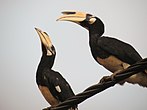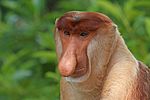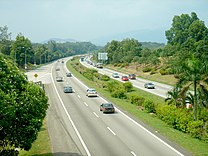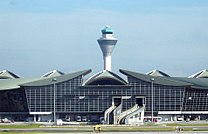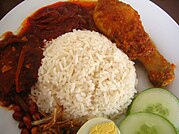Malaysia
Malaysia
| ||
|---|---|---|
Motto: Bersekutu Bertambah Mutu
| ||
| Religion (2020)[5] |
| |
| Demonym(s) | Malaysian | |
| Government | Federal parliamentary constitutional elective monarchy | |
• Yang di-Pertuan Agong (King) | Ibrahim Iskandar | |
| Anwar Ibrahim | ||
| Mutang Tagal | ||
| Johari Abdul | ||
| Tengku Maimun Tuan Mat | ||
| Legislature | North Borneo self-governance | 31 August 1963[7] |
| 16 September 1963 | ||
+60 | ||
| ISO 3166 code | MY | |
| Internet TLD | .my | |
Malaysia[d] is a country in Southeast Asia. The federal constitutional monarchy consists of 13 states and three federal territories, separated by the South China Sea into two regions: Peninsular Malaysia and Borneo's East Malaysia. Peninsular Malaysia shares a land and maritime border with Thailand and maritime borders with Singapore, Vietnam, and Indonesia. East Malaysia shares land and maritime borders with Brunei and Indonesia, as well as a maritime border with the Philippines and Vietnam. Kuala Lumpur is the national capital, the country's largest city, and the seat of the legislative branch of the federal government.
The country has its origins in the
The country is
After independence, the
Etymology
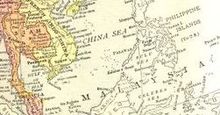
The name
At some point, the
Before the onset of European colonisation, the Malay Peninsula was known natively as
The state that gained independence from the United Kingdom in 1957 took the name the Federation of Malaya, chosen in preference to other potential names such as Langkasuka, after the historic kingdom located at the upper section of the Malay Peninsula in the first millennium CE.[35][36] The name Malaysia was adopted in 1963 when the existing states of the Federation of Malaya, plus Singapore, North Borneo and Sarawak formed a new federation.[37][e] One theory posits the name was chosen so that si represented the inclusion of Singapore, North Borneo, and Sarawak to Malaya in 1963.[37] Politicians in the Philippines contemplated renaming their state Malaysia before the modern country took the name.[39]
History
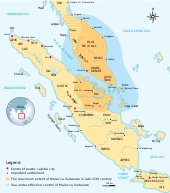
Evidence of modern human habitation in Malaysia dates back 40,000 years.

In 1511,
In the
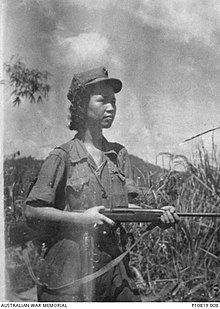
During this time, the mostly ethnically Chinese rebels under the leadership of the Malayan Communist Party launched guerrilla operations designed to force the British out of Malaya. The Malayan Emergency (1948–1960) involved a long anti-insurgency campaign by Commonwealth troops in Malaya.[58] On 31 August 1957, Malaya became an independent member of the Commonwealth of Nations.[59] Subsequently, a comprehensive plan was devised to unite Malaya with the crown colonies of North Borneo (known as Sabah upon joining), Sarawak, and Singapore. The envisioned federation was originally intended to take place on 31 August 1963, to coincide with the commemoration of Malayan independence. However, due to the necessity of conducting a survey on the level of support for the federation in Sabah and Sarawak by the United Nations, as requested by opponents of the federation such as Indonesia's Sukarno and the Sarawak United Peoples' Party, the date of the federation was postponed until 16 September 1963. This delay allowed sufficient time for the completion of the aforementioned survey.[60][61]
The federation brought heightened tensions including a
In the late 1990s, the
Government and politics
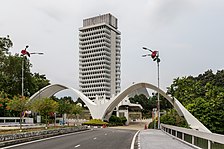
Malaysia is a
Legislative power is divided between federal and state legislatures. The bicameral federal

After UMNO lost power at the
Malaysia is marked at 48th and 62nd place according to the 2021 Corruption Perceptions Index, indicating above average levels of corruption. Freedom House noted Malaysia as "partly free" in its 2018 survey.[93] A lawsuit filed by the Department of Justice alleged that at least $3.5 billion involving former prime minister Najib Razak had been stolen from Malaysia's 1MDB state-owned fund, known as the 1Malaysia Development Berhad scandal.[94][95][96]
Administrative divisions

West Malaysia (Blue) States (Red) Federal Territories |
Malaysia is a
Governance of the states is divided between the federal and the state governments, with different powers reserved for each, and the Federal government has direct administration of the federal territories.
Lower-level administration is carried out by local authorities, which include city councils, district councils, and municipal councils, although autonomous statutory bodies can be created by the federal and state governments to deal with certain tasks.[101] The federal constitution puts local authorities outside of the federal territories under the exclusive jurisdictions of the state government,[102] although in practice the federal government has intervened in the affairs of state local governments.[103] There are 154 local authorities, consisting of 14 city councils, 38 municipal councils and 97 district councils.
The 13 states are based on historical Malay kingdoms, and 9 of the 11 Peninsular states, known as the
- States
A list of thirteen states and each state capital (in parentheses):
- Federal territories
Foreign relations and military

A founding member of ASEAN[112] and OIC,[113] the country participates in many international organisations such as the United Nations (U.N.),[114] APEC,[115] the D-8 Organization for Economic Cooperation,[116] and NAM.[117] It has chaired ASEAN, OIC, and NAM in the past.[49] A former British colony, it is also a member of the Commonwealth.[118] Kuala Lumpur was the site of the first EAS in 2005.[119]
Malaysia's foreign policy is officially based on the principle of neutrality and maintaining peaceful relations with all countries, regardless of their political system.[120] The government attaches a high priority to the security and stability of Southeast Asia,[119] and seeks to further develop relations with other countries in the region. Historically the government has tried to portray Malaysia as a progressive Islamic nation[120] while strengthening relations with other Islamic states.[119] A strong tenet of Malaysia's policy is national sovereignty and the right of a country to control its domestic affairs.[74] Malaysia signed the U.N. treaty on the Prohibition of Nuclear Weapons.[121][122]
The Spratly Islands are disputed by many states in the area, and a large portion of the South China Sea is claimed by China. Unlike its neighbours of Vietnam and the Philippines, Malaysia historically avoided conflicts with China.[123] However, after the encroachment of Chinese ships in Malaysian territorial waters,[124] and breach of airspace by their military aircraft, Malaysia has become active in condemning China.[125][126] Brunei and Malaysia in 2009 announced an end to claims of each other's land, and committed to resolve issues related to their maritime borders.[127] The Philippines has a dormant claim to the eastern part of Sabah.[128] Singapore's land reclamation has caused tensions,[129] and minor maritime and land border disputes exist with Indonesia.[128][130]
The Malaysian Armed Forces have three branches: the Malaysian Army, Royal Malaysian Navy and the Royal Malaysian Air Force. There is no conscription, and the required age for voluntary military service is 18. The military uses 1.5% of the country's GDP, and employs 1.23% of Malaysia's manpower.[131] Malaysian peacekeeping forces have contributed to many U.N. peacekeeping missions, such as in Congo, Iran–Iraq, Namibia, Cambodia, Bosnia and Herzegovina, Somalia, Kosovo, East Timor and Lebanon.[49][132]
The
Human rights
Homosexuality is illegal in Malaysia,[144][145] and authorities have imposed punishments such as caning and imprisonment.[146][147] Human trafficking and sex trafficking in Malaysia are significant problems.[148][149] There have also been cases of vigilante executions and beatings against LGBT individuals in Malaysia.[150][151] The illegality of homosexuality in Malaysia has also been the forefront of Anwar Ibrahim's sodomy trials, which Anwar has called politically motivated, a characterization supported by the Working Group on Arbitrary Detention, along with Amnesty International and the Human Rights Watch.[152][153][154]
The
In July 2023, The 1975 lead singer Matty Healy slammed the country's anti-LGBTQ laws by kissing a bandmate on stage at a music festival in Kuala Lumpur causing the Ministry of Communications and Digital to cancel the 3 day event.[158]
Geography
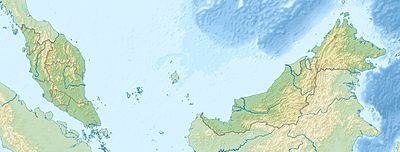
Malaysia is the
The two parts of Malaysia, separated from each other by the South China Sea, share a largely similar landscape in that both Peninsular and East Malaysia feature coastal plains rising to hills and mountains.[159] Peninsular Malaysia, containing 40 per cent of Malaysia's land area,[163] extends 740 km (460 mi) from north to south, and its maximum width is 322 km (200 mi).[165] It is divided between its east and west coasts by the Titiwangsa Mountains,[166] rising to a peak elevation of 2,183 metres (7,162 ft) at Mount Korbu,[167] part of a series of mountain ranges running down the centre of the peninsula.[163] These mountains are heavily forested,[citation needed] and mainly composed of granite and other igneous rocks. Much of it has been eroded, creating a karst landscape.[163] The range is the origin of some of Peninsular Malaysia's river systems.[citation needed] The coastal plains surrounding the peninsula reach a maximum width of 50 kilometres (31 mi), and the peninsula's coastline is nearly 1,931 km (1,200 mi) long, although harbours are only available on the western side.[165]
East Malaysia, on the island of
Around these two halves of Malaysia are numerous islands, the largest of which is Banggi.[171] The local climate is equatorial and characterised by the annual southwest (April to October) and northeast (October to February) monsoons.[165] The temperature is moderated by the presence of the surrounding oceans.[163] Humidity is usually high, and the average annual rainfall is 250 cm (98 in).[165] The climates of the Peninsula and the East differ, as the climate on the peninsula is directly affected by wind from the mainland, as opposed to the more maritime weather of the East. Local climates can be divided into three regions, highland, lowland, and coastal.[163] Climate change will cause sea level rise and increased rainfall, increasing flood risks and leading to droughts.[172]
Biodiversity and conservation
Malaysia signed the Rio Convention on Biological Diversity on 12 June 1993, and became a party to the convention on 24 June 1994.[173] It has subsequently produced a National Biodiversity Strategy and Action Plan, which was received by the convention on 16 April 1998.[174] The country is megadiverse with a high number of species and high levels of endemism.[175] It is estimated to contain 20 per cent of the world's animal species.[176] High levels of endemism are found on the diverse forests of Borneo's mountains, as species are isolated from each other by lowland forest.[163]
There are about 210 mammal species in the country.
Nearly 4,000 species of fungi, including lichen-forming species have been recorded from Malaysia. Of the two fungal groups with the largest number of species in Malaysia, the
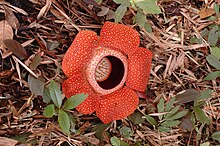
About two thirds of Malaysia was covered in forest as of 2007,
The Malaysian government aims to balance economic growth with environmental protection, but has been accused of favouring big business over the environment.
Economy

Malaysia is a relatively
Malaysia is the world's 23rd-largest exporter and 25th-largest importer.[198][199] However, economic inequalities exist between different ethnic groups.[200] The Chinese make up about one-quarter of the population, but account for 70 per cent of the country's market capitalisation.[201] Chinese businesses in Malaysia are part of the larger bamboo network, a network of overseas Chinese businesses in the Southeast Asian market sharing common family and cultural ties.[202]
International trade, facilitated by the shipping route in adjacent
The country has developed into a centre of
Infrastructure
Railway transport in Malaysia is state-run, and spans some 2,783 kilometres (1,729 mi).[217] As of 2016[update], Malaysia has the world's 26th-largest road network, with some 238,823 kilometres (148,398 mi) of roads. Malaysia's inland waterways are the world's 22nd-longest, and total 7,200 km (4,474 mi).[218] Among Malaysia's 114 airports,[219] among which the busiest is Kuala Lumpur International Airport located south of Kuala Lumpur in Sepang District, which is also the twelfth-busiest airport in Asia. Among the 7 federal ports, the major one is Port Klang,[220] which is the thirteenth-busiest container port.[221] Malaysia's flag carrier is Malaysia Airlines, providing international and domestic air services.[222]
Malaysia's
Demographics


According to the Malaysian Department of Statistics, the country's population was 32,447,385 in 2020,
Malaysian citizens are divided along local ethnic lines, with 69.7 per cent considered
There are also two other non-Bumiputera local ethnic groups. 22.8 per cent of the population are
The population is concentrated on Peninsular Malaysia,
| Rank | Name | State | Pop. | Rank | Name | State | Pop. | ||
|---|---|---|---|---|---|---|---|---|---|
 Kuala Lumpur  Kajang |
1 | Kuala Lumpur | Federal Territory |
1,982,112 | 11 | Ipoh | Perak | 759,952 |  Seberang Perai  Subang Jaya |
| 2 | Kajang | Selangor | 1,047,356 | 12 | Seremban | Negeri Sembilan | 681,541 | ||
| 3 | Seberang Perai | Penang | 946,092 | 13 | Iskandar Puteri | Johor | 575,977 | ||
| 4 | Subang Jaya | Selangor | 902,086 | 14 | Kuantan | Pahang | 548,014 | ||
| 5 | Klang | Selangor | 902,025 | 15 | Sungai Petani | Kedah | 545,053 | ||
| 6 | Johor Bahru | Johor | 858,118 | 16 | Ampang Jaya | Selangor | 531,904 | ||
| 7 | Shah Alam | Selangor | 812,327 | 17 | Kota Kinabalu | Sabah | 500,425 | ||
| 8 | George Town | Penang | 794,313 | 18 | Malacca City | Malacca | 453,904 | ||
| 9 | Petaling Jaya | Selangor | 771,687 | 19 | Sandakan | Sabah | 439,050 | ||
| 10 | Selayang | Selangor | 764,327 | 20 | Alor Setar | Kedah | 423,868 | ||
Religion

Dark green: Muslim majority > 50%
Light green: Muslim plurality < 50%
Blue: Christian majority > 50%
The constitution grants freedom of religion, while establishing Islam as the "religion of the Federation".[251][252] According to the Population and Housing Census 2020 figures, ethnicity and religious beliefs correlate highly. Approximately 63.5% of the population practise Islam, 18.7% practise Buddhism, 9.1% Christianity, 6.1% Hinduism and 1.3% practise Confucianism, Taoism and other traditional Chinese religions. 2.7% declared no religion or practised other religions or did not provide any information.[233] The states of Sarawak, Penang and the federal territory of Kuala Lumpur have non-Muslim majorities.[253][254]
Languages
The official and national language of Malaysia is
English remains an active second language, with its use allowed for some official purposes under the National Language Act of 1967.[266] In Sarawak, English is an official state language alongside Malay.[267][268][269] Historically, English was the de facto administrative language; Malay became predominant after the 1969 race riots (13 May incident).[270] Malaysian English, also known as Malaysian Standard English, is a form of English derived from British English. Malaysian English is widely used in business, along with Manglish, which is a colloquial form of English with heavy Malay, Chinese, and Tamil influences. The government discourages the use of non-standard Malay but has no power to issue compounds or fines to those who use what is perceived as improper Malay on their advertisements.[271][272]
Many other languages are used in Malaysia, which contains speakers of 137 living languages.
Health
Malaysia operates an efficient and widespread
Malaysia spent 3.83% of its GDP on healthcare in 2019.
In 2021, the principal cause of death among Malaysian adults was
Education
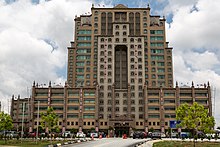
The education system of Malaysia features a non-compulsory kindergarten education followed by six years of compulsory primary education, and five years of optional secondary education.[292] Schools in the primary education system are divided into two categories: national primary schools, which teach in Malay, and vernacular schools, which teach in Chinese or Tamil.[293] Secondary education is conducted for five years. In the final year of secondary education, students sit for the Malaysian Certificate of Education examination.[294] Since the introduction of the matriculation programme in 1999, students who completed the 12-month programme in matriculation colleges can enroll in local universities. However, in the matriculation system, only 10 per cent of places are open to non-bumiputera[jargon] students.[295]
Culture
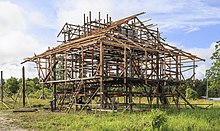
Malaysia has a multi-ethnic, multicultural, and multilingual society. Substantial influence exists from
In 1971, the government created a "National Cultural Policy", defining Malaysian culture. It stated that Malaysian culture must be based on the culture of the indigenous peoples of Malaysia, that it may incorporate suitable elements from other cultures, and that Islam must play a part in it.[298] It also promoted the Malay language above others.[299] This government intervention into culture has caused resentment among non-Malays who feel their cultural freedom was lessened. Both Chinese and Indian associations have submitted memorandums to the government, accusing it of formulating an undemocratic culture policy.[298]
Fine arts
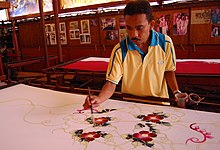
Traditional Malaysian art was mainly centred on the areas of carving, weaving, and silversmithing.
Traditional Malay music and performing arts appear to have originated in the
-
kompang
-
dholak
-
gong
-
geduk
Malaysia has a strong oral tradition that has existed since before the arrival of writing, and continues today. Each of the Malay Sultanates created their own literary tradition, influenced by pre-existing oral stories and by the stories that came with Islam.[304] The first Malay literature was in the Arabic script. The earliest known Malay writing is on the Terengganu stone, made in 1303.[163] Chinese and Indian literature became common as the numbers of speakers increased in Malaysia, and locally produced works based in languages from those areas began to be produced in the 19th century.[304] English has also become a common literary language.[163] In 1971, the government took the step of defining the literature of different languages. Literature written in Malay was called "the national literature of Malaysia", literature in other bumiputera languages was called "regional literature", while literature in other languages was called "sectional literature".[299] Malay poetry is highly developed, and uses many forms. The Hikayat form is popular, and the pantun has spread from Malay to other languages.[304]
Cuisine
Malaysia's cuisine reflects the multi-ethnic makeup of its population.
Sometimes food not found in its original culture is assimilated into another; for example, Chinese restaurants in Malaysia often serve Malay dishes.
Media

Malaysia's main newspapers are owned by the government and political parties in the ruling coalition,[312][313] although some major opposition parties also have their own, which are openly sold alongside regular newspapers. A divide exists between the media in the two halves of the country. Peninsular-based media gives low priority to news from the East, and often treats the eastern states as colonies of the peninsula.[314] As a result of this, East Malaysia region of Sarawak launched TV Sarawak as internet streaming beginning in 2014, and as TV station on 10 October 2020[315] to overcome the low priority and coverage of Peninsular-based media and to solidify the representation of East Malaysia.[316] The media have been blamed for increasing tension between Indonesia and Malaysia, and giving Malaysians a bad image of Indonesians.[317] The country has Malay, English, Chinese, and Tamil dailies.[314] Kadazandusun and Bajau news are only available via TV broadcast Berita RTM.[318] Written Kadazan news was once included in publications such as The Borneo Post, the Borneo Mail, the Daily Express, and the New Sabah Times, but publication has ceased with the newspaper or as a section.[319][320]
Holidays and festivals

Malaysians observe a number of holidays and festivities throughout the year. Some are federally gazetted
Sports
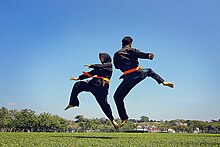
Popular sports in Malaysia include
The Federation of Malaya Olympic Council was formed in 1953, and received recognition by the IOC in 1954. It first participated in the 1956 Melbourne Olympic Games. The council was renamed the Olympic Council of Malaysia in 1964, and has participated in all but one Olympic games since its inception. The largest number of athletes ever sent to the Olympics was 57 to the 1972 Munich Olympic Games.[339] Besides the Olympic Games, Malaysia also participates in the Paralympic Games.[340] Malaysia has competed at the Commonwealth Games since 1950 as Malaya, and 1966 as Malaysia, and the games were hosted in Kuala Lumpur in 1998.[341][342]
See also
- List of Malaysia-related topics
- Outline of Malaysia
- List of countries with multiple capitals
Notes
- ^ Section 9 of the National Language Act 1963/67 states that "The script of the national language shall be the Rumi script: provided that this shall not prohibit the use of the Malay script, more commonly known as the Jawi script, of the national language".
- ^ Section 2 of the National Language Act 1963/67 states that "Save as provided in this Act and subject to the safeguards contained in Article 152(1) of the Constitution relating to any other language and the language of any other community in Malaysia the national language shall be used for official purposes".
- ^ Federal Constitution of Malaysia and National Language Act 1963/67.
- ^ UK: /məˈleɪziə/ ⓘ mə-LAY-zee-ə; US: /məˈleɪʒə/ mə-LAY-zhə; Malay: [malɛjsia] ⓘ
- ^ In English, the official name of the country is simply "Malaysia". In Malay, the name of the country as it appears on some official documents, including the oath of Yang di-Pertuan Agong is Persekutuan Malaysia, meaning "Federation of Malaysia". Despite this, the name Malaysia is mostly used officially, including the Malaysia Agreement 1963 and the Federal Constitution.[38]
References
- ^ "Malaysian Flag and Coat of Arms". Malaysian Government. Archived from the original on 22 October 2013. Retrieved 9 September 2013.
- ^ "Minister: Census shows Malaysia's oldest man and woman aged 120 and 118; preliminary census findings to be released in Feb 2022". Malaymail. 17 January 2022. Retrieved 17 January 2022.
- ^ Department of Statistics Malaysia (2021). "Current population and estimates, Malaysia 2021 Group". Retrieved 1 February 2022.
- ^ "The States, Religion and Law of the Federation" (PDF). Constitution of Malaysia. Judicial Appointments Commission. Archived from the original (PDF) on 14 June 2017. Retrieved 29 October 2017.
Islam is the religion of the Federation; but other religions may be practised in peace and harmony in any part of the Federation.
- ^ "Distribution and Basic Demographic Characteristic Report 2020". Department of Statistics, Malaysia. 14 February 2020.
- ISBN 978-1-85043-844-1.
- ^ "31 Ogos 1963, Hari kemerdekaan Sabah yang rasmi". AWANI. 14 May 2021. Retrieved 1 September 2021.
- ^ a b "Laporan Kiraan Permulaan 2010". Jabatan Perangkaan Malaysia. p. 27. Archived from the original on 27 December 2010. Retrieved 2 August 2023.
- ^ "Malaysia country profile". BBC News. 24 February 2020. Retrieved 27 January 2021.
- ^ "Malaysia". The World Factbook (2024 ed.). Central Intelligence Agency. Retrieved 24 September 2022. (Archived 2022 edition.)
- ^ "Population and Housing Census of Malaysia 2020". Department of Statistics, Malaysia. p. 48. Archived from the original on 28 February 2022. Retrieved 23 March 2022.
- ^ a b c d "World Economic Outlook Database, April 2024 Edition. (Malaysia)". www.imf.org. International Monetary Fund. 16 April 2024. Retrieved 17 April 2024.
- ^ "Gini Index". World Bank. Retrieved 20 December 2018.
- ^ "Human Development Report 2023/2024" (PDF). United Nations Development Programme. 13 March 2024. Archived (PDF) from the original on 13 March 2024. Retrieved 13 March 2024.
- ^ "Malaya in World War II". World War Two Database. Retrieved 29 January 2023.
- ISBN 978-1-107-50718-0.
- ISBN 978-0-7864-1814-5.
- ^ "The World Factbook – Malaysia". Central Intelligence Agency. 2020.
- ^ ISBN 978-9971-69-279-7
- ISBN 978-81-87586-24-1.
- ISBN 978-81-208-0302-2.
- ISBN 978-81-7030-462-3.
- ISBN 978-81-215-0114-9.
- ^ Sarkar, Himansu Bhusan (1970). Some contributions of India to the ancient civilisation of Indonesia and Malaysia. Punthi Pustak. p. 8.
- ISBN 978-967-61-1809-7
- ISBN 978-1-4443-3903-1
- ^ S2CID 62886471.
- ISBN 978-0-521-87237-9.
- ISBN 978-0-87220-458-4.
- ^ Painter, Nell Irvin (7–8 November 2003). "Collective Degradation: Slavery and the Construction of Race" (PDF). Proceedings of the Fifth Annual Gilder Lehrman Center International Conference at Yale University. New Haven, Connecticut: Yale University. p. 18. Archived from the original (PDF) on 20 October 2013. Retrieved 13 May 2014.
- S2CID 162374626.
- ^ Earl, George S. W. (1850). "On The Leading Characteristics of the Papuan, Australian and Malay-Polynesian Nations". Journal of the Indian Archipelago and Eastern Asia (JIAEA). IV: 119.
- ^ Barrows, David P. (1905). A History of the Philippines. American Book Company. pp. 25–26.
- ^ Clifford, Hugh Charles (1911). . In Chisholm, Hugh (ed.). Encyclopædia Britannica. Vol. 17 (11th ed.). Cambridge University Press. pp. 475–478.
- ^ ISBN 978-962-593-470-9.
- ^ "Federation of Malaya Independence Act 1957 (c. 60)e". The UK Statute Law Database. 31 July 1957. Retrieved 6 November 2010.
- ^ a b c Spaeth, Anthony (9 December 1996). "Bound for Glory". Time. New York. Archived from the original on 17 March 2009. Retrieved 20 August 2011.
- ^ "Federal Constitution" (PDF). Malaysian Anti-Corruption Commission (SPRM). Government of Malaysia. Retrieved 22 March 2024.
- ISBN 978-0-415-55130-4. Archived from the original(PDF) on 13 October 2014.
- stuff.co.nz. Retrieved 6 January 2014.
- JSTOR 681964.
- ^ Tsang, Cheng-hwa (2000), "Recent advances in the Iron Age archaeology of Taiwan", Bulletin of the Indo-Pacific Prehistory Association, 20: 153–158, doi:10.7152/bippa.v20i0.11751
- ^ Turton, M. (2021). Notes from central Taiwan: Our brother to the south. Taiwan's relations with the Philippines date back millennia, so it's a mystery that it's not the jewel in the crown of the New Southbound Policy. Taiwan Times.
- ^ Everington, K. (2017). Birthplace of Austronesians is Taiwan, capital was Taitung: Scholar. Taiwan News.
- ^ Bellwood, P., H. Hung, H., Lizuka, Y. (2011). Taiwan Jade in the Philippines: 3,000 Years of Trade and Long-distance Interaction. Semantic Scholar.
- ISBN 978-3-11-013417-9.
- ^ Suporno, S. (1979). "The Image of Majapahit in late Javanese and Indonesian Writing". In A. Reid; D. Marr (eds.). Perceptions of the Past. Southeast Asia publications. Vol. 4. Singapore: Heinemann Books for the Asian Studies Association of Australia. p. 180.
- JSTOR 20067505.
- ^ a b c d e f g h i j k l m n "Malaysia". United States State Department. 14 July 2010. Retrieved 14 September 2010.
- ^ Luscombe, Stephen. "The Map Room: South East Asia: Malaya". Retrieved 18 September 2010.
- ^ Clifford, Hugh Charles; Graham, Walter Armstrong (1911). . In Chisholm, Hugh (ed.). Encyclopædia Britannica. Vol. 17 (11th ed.). Cambridge University Press. pp. 478–484.
- ^ Kuar, Amarjit. "International Migration and Governance in Malaysia: Policy and Performance" (PDF). University of New England. Archived from the original (PDF) on 9 May 2010. Retrieved 20 December 2011.
- ISBN 978-0-7100-4141-8.
- ^ Luscombe, Stephen. "The Map Room: South East Asia: North Borneo". Retrieved 1 July 2011.
- ISBN 978-981-230-457-5.
- ^ Mohamad, Mahathir (31 May 1999). "Our Region, Ourselves". Time. New York. Archived from the original on 12 February 2001. Retrieved 26 October 2010.
- ^ "MALAYA: Token Citizenship". Time. New York. 19 May 1952. Archived from the original on 6 November 2007. Retrieved 26 October 2010.
- ^ "The Malayan Emergency: 1948–1960". Australian Government Department of Veteran Affairs. Archived from the original on 6 July 2011. Retrieved 1 July 2011.
- ^ "1957: Malaya celebrates independence". BBC News. Retrieved 9 August 2016.
- ^ "Malaysia: Tunku Yes, Sukarno No". Time. New York. 6 September 1963. Archived from the original on 2 April 2008. Retrieved 17 October 2010.
- ISBN 978-981-230-154-3.
- ^ "Proclamation on Singapore". Singapore Attorney-General. Archived from the original on 11 May 2011. Retrieved 27 October 2010.
- ^ "Malaysia: The Art of Dispelling Anxiety". Time. New York. 27 August 1965. Archived from the original on 30 September 2007. Retrieved 26 October 2010.
- ^ "Race War in Malaysia". Time. New York. 23 May 1969. Archived from the original on 16 February 2007. Retrieved 26 October 2010.
- ^ a b Sundaram, Jomo Kwame (1 September 2004). "The New Economic Policy and Interethnic Relations in Malaysia". UNRISD. Retrieved 27 October 2010.
- ^ Ping Lee Poh; Yean Tham Siew. "Malaysia Ten Years After The Asian Financial Crisis" (PDF). Thammasat University. Archived from the original (PDF) on 1 April 2010. Retrieved 25 July 2011.
- ^ "Malaysian taskforce investigates allegations $700m paid to Najib". The Guardian. London. 6 July 2015. Retrieved 24 March 2018.
- ^ a b "Malaysia election: Opposition scores historic victory". BBC News. 10 May 2018. Retrieved 6 April 2019.
- ^ Walden, Max (13 January 2021). "How Malaysia went from fewer COVID cases than Australia to a national state of emergency". ABC News (Australia). Retrieved 19 July 2021.
- ^ "No clear winner as Malaysia election ends in hung parliament". www.aljazeera.com. 19 November 2022.
- ^ "Anwar Ibrahim sworn in as Malaysian PM after post-election deadlock". BBC News. 24 November 2022.
- ^ "Could Federalism Smooth Southeast Asia's Rough Edges?". Stratfor. 26 January 2018.
- ^ a b "Malaysia Information". Federation of International Trade Associations. Archived from the original on 26 December 2010. Retrieved 27 October 2010.
- ^ a b c d "Malaysia country brief". Australian Government Department of Foreign Affairs and Trade. February 2014. Retrieved 22 October 2014.
- ^ "Background". Parlimen Malaysia. 3 June 2010. Retrieved 25 July 2011.
- ISBN 978-0-88645-060-1.
- ^ "Malaysia (Dewan Rakyat)". Inter-Parliamentary Union. 29 September 2008.
- ^ Martin Carvalho; Hemananthani Sivanandam; Rahimy Rahim; Tarrence Tan (16 July 2019). "Dewan Rakyat passes Bill to amend Federal Constitution to lower voting age to 18". The Star. Retrieved 16 July 2019.
- ^ "Palace: Muhyiddin to be sworn in as PM". The Star Online. 29 February 2020. Retrieved 29 February 2020.
- ^ "Ismail Sabri sworn in as Malaysia's ninth Prime Minister". The Star. 21 August 2021. Retrieved 22 August 2021.
- ^ "Malaysia's Ismail Sabri Yaakob sworn in as new PM".
- ^ "Attacks on Justice – Malaysia" (PDF). International Commission of Jurists. Archived from the original (PDF) on 19 January 2012. Retrieved 5 December 2011.
- ^ "Malaysian criminal court system". Association of Commonwealth Criminal Lawyers. Archived from the original on 15 May 2011. Retrieved 15 December 2010.
- ^ "Dasar Ekonomi Baru". Pusat Maklumat Rakyat. 14 November 2008. Retrieved 21 November 2010.
- ISSN 1020-8194. Retrieved 22 August 2011.
- ^ Perlez, Jane (24 August 2006). "Once Muslim, Now Christian and Caught in the Courts". The New York Times. Retrieved 22 August 2011.
- ^ "Malaysian state passes Islamic law". BBC News. 8 July 2002. Retrieved 27 November 2011.
- ^ "Kelantan's passing of hudud amendments void". The Star. Kuala Lumpur. 23 March 2015. Retrieved 1 April 2015.
- ^ "BN won't declare hudud support, but individual members can, chief whip says". Malay Mail. Kuala Lumpur. 31 March 2015. Retrieved 1 April 2015.
- ^ "Democracy Index 2019 A year of democratic setbacks and popular protest". EIU.com. Retrieved 27 October 2020.
- ^ "2020 World Press Freedom Index". Reporters Without Borders. 2020. Retrieved 27 October 2020.
- ^ "Malaysia : Back to harassment, intimidation and censorship | Reporters without borders". RSF. Retrieved 26 July 2021.
- ^ "Malaysia considers amending human trafficking law after U.S. report". Reuters. 29 June 2018.
- ^ "1MDB: The inside story of the world's biggest financial scandal". The Guardian. 28 July 2016. Archived from the original on 11 November 2019.
- ^ "1MDB: The playboys, PMs and partygoers around a global financial scandal". BBC News. 9 August 2019.
- ^ "The bizarre story of 1MDB, the Goldman Sachs-backed Malaysian fund that turned into one of the biggest scandals in financial history". Business Insider. 9 August 2019.
- ^ "Understanding the Federation of Malaysia". The Star. Kuala Lumpur. 2 November 2015. Archived from the original on 5 November 2015. Retrieved 3 November 2015.
- ^ "Malaysia Districts". Statoids. Retrieved 3 November 2010.
- ^ "Federal Territories and State Governments". Malaysian government. Archived from the original on 22 February 2014. Retrieved 15 October 2013.
- ISBN 978-92-1-131313-0.
- ^ "Malaysia's government procurement regime" (PDF). Ministry of Finance Malaysia. Archived from the original (PDF) on 3 March 2016. Retrieved 19 February 2014.
- ^ "Introduction to local government in Malaysia" (PDF). Universiti Teknologi Mara. Archived from the original (PDF) on 28 March 2018. Retrieved 19 February 2014.
- ^ Nooi, Phang Siew (May 2008). "Decentralisation or recentralisation? Trends in local government in Malaysia". Commonwealth Journal of Local Governance. Retrieved 19 February 2014.
- ^ Hai, Lim Hong. "Electoral Politics in Malaysia: 'Managing' Elections in a Plural Society" (PDF). Retrieved 19 February 2014.
- ISBN 978-0-7923-1977-1.
- S2CID 154586268.
- ^ Bong, Karen & Pilo, Wilfred (16 September 2011). "An agreement forged and forgotten". The Borneo Post. Kuching. Retrieved 3 July 2014.
- ^ Koay, Su Lin (September 2016). "Penang: The Rebel State (Part One)". Penang Monthly. Archived from the original on 1 December 2017. Retrieved 26 November 2017.
- . Retrieved 3 November 2015.
- ^ Mohd Hazmi Mohd Rusli (18 October 2015). "Could the Federation of Malaysia really come apart?". Astro Awani. Retrieved 3 November 2015.
- ^ "Will things fall apart in the Malaysian federation?". Today. Singapore. 3 November 2015. Retrieved 3 November 2015.
- ^ "Overview". Association of Southeast Asian Nations. Archived from the original on 9 January 2008. Retrieved 8 November 2007.
- ^ "Islamic Affairs (OIC) and D8 Division". Malaysian Ministry of Foreign Affairs. Archived from the original on 9 March 2017. Retrieved 12 November 2010.
- ^ "List of Member States". United Nations. Archived from the original on 24 October 2007. Retrieved 8 November 2007.
- ^ "Member Economies". Asia-Pacific Economic Cooperation. Archived from the original on 1 December 2010. Retrieved 10 June 2011.
- ^ "Malaysia". Developing 8 Countries. Archived from the original on 30 June 2017. Retrieved 15 October 2013.
- ^ "The Non-Aligned Movement: Member States". Non-Aligned Movement. Archived from the original on 9 December 2010. Retrieved 5 September 2010.
- ^ "Member States". Commonwealth Secretariat. Retrieved 26 October 2010.
- ^ a b c "Malaysia Foreign Relations". New Zealand Ministry of Foreign Affairs and Trade. 4 December 2008. Archived from the original on 26 May 2010. Retrieved 18 September 2010.
- ^ a b "Malaysia's Foreign Policy". Ministry of Foreign Affairs. Retrieved 21 September 2010.
- ^ "Chapter XXVI: Disarmament – No. 9 Treaty on the Prohibition of Nuclear Weapons". United Nations Treaty Collection. 7 July 2017.
- ^ "Japan should support nuclear ban treaty, says Malaysian PM Mahathir Mohamad". The Japan Times. 7 August 2019.
- ^ Diola, Camille (25 June 2014). "Why Malaysia, unlike Philippines, keeps quiet on sea row". The Philippine Star. Retrieved 25 June 2014.
- ^ "Presence of China Coast Guard ship at Luconia Shoals spooks local fishermen". The Borneo Post. Kuching. 27 September 2015. Retrieved 28 September 2015.
- ^ "Malaysia lodges diplomatic protest against intrusion at Beting Patinggi Ali". The Rakyat Post. Bernama. 15 August 2015. Archived from the original on 29 September 2015. Retrieved 16 August 2015.
- ^ Blanchard, Ben; Pullin, Richard (18 October 2015). "Malaysia slams China's 'provocation' in South China Sea". Channel News Asia. Reuters. Archived from the original on 19 October 2015. Retrieved 20 October 2015.
- ^ Masli, Ubaidillah (17 March 2009). "Brunei drops all claims to Limbang". The Brunei Times. Archived from the original on 12 July 2014. Retrieved 23 August 2013.
- ^ a b Mohamad, Kadir (2009). "Malaysia's territorial disputes – two cases at the ICJ: Batu Puteh, Middle Rocks and South Ledge (Malaysia/Singapore), Ligitan and Sipadan [and the Sabah claim] (Malaysia/Indonesia/Philippines)" (PDF). Institute of Diplomacy and Foreign Relations (IDFR) Ministry of Foreign Affairs, Malaysia. p. 46. Archived from the original (PDF) on 16 May 2016. Retrieved 16 May 2014.
Map of British North Borneo, highlighting in yellow colour the area covered by the Philippine claim, presented to the Court by the Philippines during the Oral Hearings at the ICJ on 25 June 2001
- ^ "Disputed – International". CIA. Archived from the original on 14 October 2018. Retrieved 26 October 2010.
- ^ "Border disputes differ for Indonesia, M'sia". Daily Express. Kota Kinabalu. 16 October 2015. Archived from the original on 19 October 2015. Retrieved 19 October 2015.
- ^ "Malaysian Military statistics". NationMaster. Retrieved 1 October 2010.
- ^ "Malaysia – Permanent Missions to the United Nations" (PDF). United Nations. 12 February 2013. Archived from the original (PDF) on 18 October 2013. Retrieved 15 October 2013.
- ^ "Australia says major military exercise underway in Malaysia". My Sinchew. 26 April 2010. Archived from the original on 3 March 2016. Retrieved 1 October 2010.
- ^ Wood, Daniel (20 April 2014). "Brunei, M'sia train in 11th military exercise". The Brunei Times. Archived from the original on 8 December 2014. Retrieved 5 November 2014.
- ^ Yao Jianing (17 September 2015). "First China-Malaysia joint military exercise held in Malacca Strait". China Military Online. Ministry of National Defense of the People's Republic of China. Archived from the original on 1 October 2018. Retrieved 1 October 2018.
- ^ Aman Anand (30 April 2018). "First Ever Joint Army exercise on Malaysian Soil Commences with Handing-Over of Troops Ceremony". Press Information Bureau (India). Archived from the original on 1 October 2018. Retrieved 2 October 2018.
- ^ "Indonesia-Malaysia military exercises must continue – defence minister". ANTARA News. 13 September 2010. Archived from the original on 22 September 2010. Retrieved 1 October 2010.
- Jane's Information Group. Archived from the originalon 1 October 2018. Retrieved 1 October 2018.
- ^ "Malaysia, US armed forces in joint exercise". The Star. Kuala Lumpur. 25 August 2014. Retrieved 26 August 2014.
- ^ "Malaysia, Philippines committed to enhancing border security". My Sinchew. 9 August 2010. Archived from the original on 3 March 2016. Retrieved 18 September 2010.
- ^ "Piracy in Southeast Asia: Organised Criminal Syndicates or Small Scale Opportunists?" (PDF). Gray Page. April 2013. Archived from the original (PDF) on 24 July 2015. Retrieved 24 July 2015.
- ^ Carvalho, Martin (15 May 2012). "Malaysia, Thailand military exercise to include other agencies, Asean members". The Star. Kuala Lumpur. Retrieved 5 November 2014.
- ^ Kent, Jonathan (28 April 2004). "Malaysia ups Thai border security". BBC News. Retrieved 18 September 2010.
- ^ Bearak, Max; Cameron, Darla (16 June 2016). "Here are the 10 countries where homosexuality may be punished by death". The Washington Post.
- ^ Avery, Daniel (4 April 2019). "71 Countries Where Homosexuality is Illegal". Newsweek.
- ^ Lamb, Kate (3 September 2018). "Women caned in Malaysia for attempting to have lesbian sex". The Guardian. London. Retrieved 26 May 2019.
- ^ "Malaysia sentences five men to jail, caning and fines for gay sex". Reuters. 7 November 2019. Retrieved 27 June 2022.
- ^ "Malaysia must wake up to its human trafficking problem". New Mandala. 24 May 2017.
- ^ "US penalises Malaysia for shameful human trafficking record". The Guardian. 20 June 2014.
- ^ "A brutal assault and rising fear in Malaysia's LGBT community". The Star. 24 August 2018. Retrieved 27 June 2022.
- ^ "Malaysia: Government Steps Up Attacks on LGBT People". Human Rights Watch. 25 January 2021. Retrieved 27 June 2022.
- ^ "Malaysia: Political Motivations Undermine Anwar Case". Human Rights Watch. 21 July 2008.
- ^ Doherty, Ben (10 February 2015). "Anwar Ibrahim guilty in sodomy case". the Guardian. Retrieved 27 June 2022.
- ^ "Anwar Ibrahim: Malaysia opposition leader 'should be freed'". BBC News. 2 November 2015. Retrieved 27 June 2022.
- ^ "Laws of Malaysia [Act 574]" (PDF). Attorney General's Chamber. 1 January 2015. Archived from the original (PDF) on 3 December 2020. Retrieved 13 October 2016.
- ^ "The Death Penalty in Malaysia" (PDF). Government of the United Kingdom. Retrieved 15 October 2013.
- ^ "Malaysia renews pledge to abolish mandatory death penalty". Reuters. 10 June 2022. Retrieved 10 June 2022.
- ^ Heather Chen; Teele Rebane; Lauren Kent (22 July 2023). "Malaysia halts music festival after same-sex kiss by The 1975 singer". CNN. Retrieved 23 July 2023.
- ^ a b c d e f "Malaysia". CIA. Retrieved 27 March 2014.
- ^ "To Reduce Conflicts, Indonesia and Malaysia Should Meet Intensively". Universitas Gadjah Mada. Retrieved 26 October 2010.
- ISBN 978-1-897643-43-3.
- ^ "Brunei". CIA. Retrieved 13 September 2011.
- ^ ISBN 978-0-7614-7642-9.
- ^ Schuman, Michael (22 April 2009). "Waterway To the World – Summer Journey". Time. New York. Archived from the original on 23 April 2009. Retrieved 16 August 2011.
- ^ ISBN 978-981-230-730-9.
- ISBN 978-979-433-387-7.
- ISBN 978-0-8108-7641-5.
- ^ ISBN 978-1-74104-887-2.
- ISBN 978-1-84162-390-0. Retrieved 23 April 2014.
- ^ "Mount Kinabalu – revered abode of the dead". Ecology Asia. Retrieved 17 September 2010.
- ^ Daw, T. (April 2004). Reef Fish Aggregations in Sabah, East Malaysia (PDF) (Report). Western Pacific Fisher Survey series. Vol. 5. Society for the Conservation of Reef Fish Aggregations. p. 17.
- ^ "Country: Malaysia". World Bank Climate Change Knowledge Portal. Retrieved 1 February 2023.
- ^ "List of Parties". Retrieved 9 December 2012.
- ^ "Malaysia's National Policy on Biological Diversity" (PDF). Archived from the original (PDF) on 20 August 2013. Retrieved 15 October 2013.
- ^ "Biodiversity Theme Report". Australian Government Department of the Environment, Water, Heritage and the Arts. 2001. Archived from the original on 8 December 2008. Retrieved 24 January 2009.
- ^ ]
- ^ ISBN 978-1-74059-708-1.
- ^ "Exclusive Economic Zones". Sea Around Us | Fisheries, Ecosystems and Biodiversity. Retrieved 23 February 2023.
- ISBN 978-92-5-105499-4.
- ^ "Coral Triangle". WWF. Retrieved 14 September 2010.
- ^ a b c d "Saving the gardeners of the ocean". Inquirer Global Nation. 12 July 2010. Archived from the original on 10 December 2010. Retrieved 20 December 2010.
- ^ "Species diversity and food-web complexity in the caves of Malaysia". Ambient Science, 2014 Vol 1(2). Archived from the original on 3 May 2014.
- ^ Lee, S.S.; Alias, S.A.; Jones, E.B.G.; Zainuddin, N. and Chan, H.T. (2012) Checklist of Fungi of Malaysia Research Pamphlet No. 132, Ministry of Natural Resources and Environment, Malaysia.
- ^ a b c d "The Malaysian Rainforest". WWF Malaysia. Retrieved 1 October 2010.
- ISBN 978-1-84537-971-1.
- ^ ISBN 978-1-74104-887-2.
- ^ "Malaysia plans to halt all expansion of oil palm plantations, minister says". The Straits Times. Singapore. 4 March 2019. Retrieved 26 May 2019.
- ^ a b McQuillan, Rebecca (22 November 2010). "Can global summit save the tiger". The Herald. Glasgow. Archived from the original on 14 May 2011. Retrieved 20 December 2010.
- ^ "Artificial reefs to prevent illegal fishing". The Borneo Post. Kuching. 4 December 2010. Retrieved 20 December 2010.
- ^ a b Rahim, Ridzwan A. (22 June 2011). "Go: A diver's paradise". New Straits Times. Kuala Lumpur. Archived from the original on 22 June 2011. Retrieved 20 December 2010.
- ^ "Standardize illegal animal trafficking law – Ellron". The Borneo Post. Kuching. 15 December 2010. Retrieved 20 December 2010.
- ^ Boulton, William R.; Pecht, Michael; Tucker, William; Wennberg, Sam (May 1997). "Electronics Manufacturing in the Pacific Rim, World Technology Evaluation Center, Chapter 4: Malaysia". The World Technology Evaluation Center, Inc. Retrieved 1 November 2010.
- ^ "GDP – composition, by sector of origin". The World Factbook. Central Intelligence Agency. Retrieved 27 June 2022.
- ^ "Malaysia – Unemployment Rate". Moody's Analytics. Retrieved 28 June 2022.[permanent dead link]
- ^ "International Reserves of Bank Negara Malaysia as at 31 March 2022". Central Bank of Malaysia (Bank Negara Malaysia). 7 April 2022. Retrieved 27 June 2022.
- ^ "Labor force – The World Factbook". The World Factbook. Central Intelligence Agency. Retrieved 16 June 2021.
- ^ "2021 PRODUCTION STATISTICS". OICA. Retrieved 16 June 2021.
- ^ "List of importing markets for the product exported by Malaysia in 2021". International Trade Centre. Retrieved 27 June 2022.
- ^ "List of supplying markets for the product imported by Malaysia in 2021". International Trade Centre. Retrieved 27 June 2022.
- ^ Khalid, Muhammed Abdul; Yang, Li (July 2019). "Income Inequality and Ethnic Cleavages in Malaysia | Evidence from Distributional National Accounts | (1984-2014)". World Inequality Database. Retrieved 28 June 2022.
- ^ Chau, Amy. "Minority rule, majority hate". Asia Times. Archived from the original on 1 August 2003. Retrieved 15 November 2010.
{{cite web}}: CS1 maint: unfit URL (link) - ISBN 978-0-684-82289-1.
- ^ "The Security of The Straits of Malacca and Its Implications to The South East Asia Regional Security". Office of The Prime Minister of Malaysia. Archived from the original on 4 March 2014. Retrieved 21 June 2010.
- ^ "BNM National Summary Data Page". Bank Negara Malaysia. 30 September 2003. Archived from the original on 6 February 2010. Retrieved 29 October 2010.
- ^ Schuman, Michael (22 April 2009). "How to Defeat Pirates: Success in the Strait". Time. Archived from the original on 23 April 2009.
- ^ "TED Case Studies: Tin Mining In Malaysia – Present And Future". American University. Archived from the original on 30 November 2016. Retrieved 15 October 2013.
- ^ "BNM National Summary Data Page". Bank Negara Malaysia. Archived from the original on 6 February 2010. Retrieved 27 October 2010.
- ^ a b "WHO Western Pacific Region – 2006 – Malaysia – Political and socioeconomic situation". WHO. Archived from the original on 29 August 2010. Retrieved 18 October 2010.
- ^ Clover, Charles (10 June 2007). "Malaysia defends palm oil production". The Telegraph. Archived from the original on 1 December 2009. Retrieved 28 November 2010.
- ^ "SMART TOURISM: FUTURE OF TOURISM IN MALAYSIA". Malaysian Investment Development Authority. 13 June 2021. Retrieved 28 June 2022.
- ^ S2CID 241989515.
- ^ "Travel & Tourism Development Index 2021 - Rebuilding for a Sustainable and Resilient Future" (PDF). World Economic Forum. May 2022.
- ^ Gooch, Liz (September 2010). "A Path to Financial Equality in Malaysia". International Herald Tribune. Retrieved 27 September 2010.
- ^ "High-technology exports (current US$) - Singapore, Malaysia, Thailand, Indonesia | Data". data.worldbank.org.
- . Retrieved 28 October 2023.
- IMD Business School. Retrieved 28 June 2022.
- ^ "Rail lines (total route-km) - Malaysia". World Bank. Retrieved 6 July 2022.
- ^ "Waterways – The World Factbook". The World Factbook. Central Intelligence Agency. Retrieved 6 July 2022.
- ^ "Airports – The World Factbook". The World Factbook. Central Intelligence Agency. Retrieved 15 June 2021.
- .
- ^ "The Top 50 Container Ports". World Shipping Council. Washington, D.C. Retrieved 6 July 2022.
- JSTOR 2564511.
- ^ a b "Malaysian Telecommunications Overview". American University. Archived from the original on 4 May 2011. Retrieved 25 May 2011.
- ^ "Telephones – mobile cellular". The World Factbook. Archived from the original on 16 November 2011. Retrieved 25 May 2011.
- ^ a b c Guidebook on Expatriate Living in Malaysia (PDF). Malaysia Industrial Development Authority. May 2009. pp. 8–9, 69. Archived from the original (PDF) on 28 September 2011. Retrieved 20 August 2011.
- ^ Sobian, Azrina (13 December 2018). "Water is life, use it wisely, don't waste it". New Straits Times. Archived from the original on 20 September 2020. Retrieved 20 September 2020.
- ^ "Malaysia's Water Vision: The Way Forward – The Malaysian Water Partnership". Food and Agriculture Organization of the United Nations. 13 December 2018. Archived from the original on 20 September 2020. Retrieved 20 September 2020.
- ^ "Infrastructure and Rural Development in Malaysia" (PDF). Centre on Integrated Rural Development for Asia and the Pacific. Archived from the original (PDF) on 14 May 2011. Retrieved 25 May 2011.
- ^ "Tenaga Nasional Berhad 500kV Transmission System, Phase 1". Ranhill Berhad. Archived from the original on 27 February 2009. Retrieved 23 May 2009.
- ^ "Malaysia – Power Sector". AsiaTradeHub.com. Archived from the original on 18 January 2020. Retrieved 18 January 2020.
- ^ "Energy Commission". Archived from the original on 9 May 2015. Retrieved 11 April 2015.
- ^ Selamat, Salsuwanda & Abidin, Che Zulzikrami Azner. "Renewable Energy and Kyoto Protocol: Adoption in Malaysia". Universiti Malaysia Perlis. Archived from the original on 4 September 2013. Retrieved 15 October 2013.
- ^ a b c "Population Distribution and Basic Demographic Characteristics" (PDF). Department of Statistics, Malaysia. p. 82. Archived from the original (PDF) on 22 May 2014. Retrieved 4 October 2011.
- ^ "Population Distribution and Basic Demographic Characteristic Report 2010 (Ethnic composition)". Department of Statistics, Malaysia. 2010. Archived from the original on 8 October 2013. Retrieved 10 October 2013.
- ^ a b "Infographics". Department of Statistics. Retrieved 13 August 2021.
- ^ Brant, Robin (4 March 2008). "Malaysia's lingering ethnic divide". BBC News. Retrieved 29 October 2013.
- ^ "2. Socio-Economic and National Context [People]". Malaysian-Danish Country Programme for Cooperation in Environment and Development (2002–2006). Miljøstyrelsens Informationscenter. Archived from the original on 21 September 2004. Retrieved 20 September 2020.
- ^ Leong, Trinna (3 August 2017). "Who are Malaysia's bumiputera?". The Straits Times. Archived from the original on 20 September 2020. Retrieved 20 September 2020.
- ISBN 978-0-203-96075-2.
- ^ "PM asked to clarify mixed-race bumiputra status". The Star. 4 November 2009. Archived from the original on 7 November 2009. Retrieved 26 October 2010.
- ^ Kuppusamy, Baradan (24 March 2006). "Racism alive and well in Malaysia". Asia Times. Archived from the original on 24 March 2006. Retrieved 27 October 2010.
{{cite web}}: CS1 maint: unfit URL (link) - ^ ISBN 978-0-8160-7109-8.
- ^ "Malaysia: Citizenship laws, including methods by which a person may obtain citizenship; whether dual citizenship is recognized and if so, how it is acquired; process for renouncing citizenship and related documentation; grounds for revoking citizenship". Immigration and Refugee Board of Canada. 16 November 2007. Archived from the original on 24 November 2011. Retrieved 25 July 2011.
- ^ May, Leow Yong (30 August 2007). "More than just a card". The Star. Archived from the original on 5 January 2009. Retrieved 27 October 2010.
- ISBN 978-0-7546-4332-6.
- ^ Permatasari, Soraya (13 July 2009). "As Malaysia deports illegal workers, employers run short". The New York Times. Retrieved 26 October 2010.
- ^ Kent, Jonathan (29 October 2004). "Illegal workers leave Malaysia". BBC News. Retrieved 26 October 2010.
- ^ Quek, Kim. "Demographic implosion in Sabah? Really?". Malaysiakini. Retrieved 21 June 2010.
- ^ "World Refugee Survey 2009". United States Committee for Refugees and Immigrants. 17 June 2009. Retrieved 10 June 2011.
- ^ "Launching of report on the key findings population and housing census of Malaysia 2020". Department of Statistics Malaysia. 14 February 2022.
- ^ Ibrahim, Zawawi; Mohd Rasid, Imram (October 2019). "Country Profile Malaysia" (PDF). GREASE: Religion, Diversity and Radicalisation.
- ^ Ambiga Sreenevasan (18 July 2007). "PRESS STATEMENT: Malaysia a secular state". The Malaysian Bar. Archived from the original on 28 December 2018. Retrieved 6 September 2017.
- ^ "Department of Statistics Malaysia Official Portal".
- ^ "Malaysia Christians pray for peace, equality, freedom - UCA News".
- ^ ISBN 978-0-691-09508-0.
- ^ "Chapter 1: Religious Affiliation". Pew Research Center. 9 August 2012. Retrieved 4 September 2013.
- ^ "Chapter 1: Religious Affiliation". 9 August 2012. Retrieved 5 October 2016.
- ^ Mahathir, Marina (17 August 2010). "Malaysia moving forward in matters of Islam and women by Marina Mahathir". Common Ground News Service. Archived from the original on 22 December 2010. Retrieved 14 September 2010.
- ^ "Malay, Standard". Ethnologue. 2009. Retrieved 25 July 2011.
- ^ "Mahathir regrets govt focussing too much on Bahasa". Daily Express. Kota Kinabalu. 2 October 2013. Archived from the original on 12 July 2014. Retrieved 16 October 2013.
- ^ "Bahasa Rasmi" (in Malay). Malaysian Administrative Modernisation and Management Planning Unit. Retrieved 19 April 2021.
Perkara 152 Perlembagaan Persekutuan menjelaskan bahawa bahasa Melayu yang dikenali juga sebagai bahasa Malaysia adalah bahasa rasmi yang tidak boleh dipertikai fungsi dan peranannya sebagai Bahasa Kebangsaan.
- ^ Encik Md. Asham bin Ahmad (8 August 2007). "Malay Language Malay Identity". Institute of Islamic Understanding Malaysia. Retrieved 19 April 2021.
- ^ "Federal Constitution" (PDF). Judicial Appointments Commission. Archived from the original (PDF) on 24 March 2012. Retrieved 29 November 2011.
- ^ Fernandez, Kathleen (1 June 2016). "The history of Bahasa Melayu / Malaysia: The language of the Malay(sian) people". Retrieved 19 April 2021.
- .
- ^ a b National Language Act 1963/67 (PDF) (Act 32). Dewan Rakyat. 1967.
- ^ Sulok Tawie (18 November 2015). "Sarawak makes English official language along with BM". Malay Mail. Kuala Lumpur. Retrieved 18 November 2015.
- ^ "Sarawak to recognise English as official language besides Bahasa Malaysia". Borneo Post. Kuching. 18 November 2015. Archived from the original on 5 March 2016. Retrieved 18 November 2015.
- ^ "Sarawak adopts English as official language". The Sun. Kuala Lumpur. 19 November 2015. Retrieved 19 November 2015.
- ISBN 978-0-333-27672-3.
- ^ Zimmer, Benjamin (5 October 2006). "Language Log: Malaysia cracks down on "salad language"". University of Pennsylvania. Retrieved 14 September 2010.
- ^ "Dewan Bahasa champions use of BM in ads". New Straits Times. Kuala Lumpur. 14 October 2013. Archived from the original on 24 October 2013. Retrieved 16 October 2013.
- ^ "Ethnologue report for Malaysia". Ethnologue. Retrieved 18 October 2010.
- ^ "Ethnologue report for Malaysia (Peninsular)". Ethnologue. Archived from the original on 10 May 2011. Retrieved 18 October 2010.
- ISBN 978-0-7007-1286-1.
- ISBN 978-1-107-06261-0.
- ^ Schiffman, Harold F. (31 December 1998). "Malaysian Tamils and Tamil Linguistic Culture". University of Pennsylvania. Retrieved 13 June 2022.
- JSTOR 30027570.
- ISBN 978-90-272-5255-5.
- PMID 22992444.
- PMID 28299064.
The Malaysian Ministry of Health (MOH), being the main provider of health services...
- PMID 25215912.
- ^ "Current healthcare expenditure (% of GDP) - Malaysia". World Bank. Retrieved 26 June 2022.
- ^ "Life expectancy at birth, total (years) - Malaysia". World Bank. Retrieved 26 June 2022.
- ^ "Mortality rate, infant (per 1,000 live births) - Malaysia". World Bank. Retrieved 26 June 2022.
- ^ "Fertility rate, total (births per woman) - Malaysia". World Bank. Retrieved 26 June 2022.
- ^ "Birth rate, crude (per 1000 people) - Malaysia". World Bank. Retrieved 26 June 2022.
- ^ "Death rate, crude (per 1,000 people) - Malaysia". World Bank. Retrieved 26 June 2022.
- ^ "Statistics on Causes of Death, Malaysia 2021". Department of Statistics Malaysia. 16 November 2021. Retrieved 26 June 2022.
- ^ Abdelfatah, Akmal. "TRAFFIC FATALITY CAUSES AND TRENDS IN MALAYSIA" (PDF). Massachusetts Institute of Technology. Retrieved 26 June 2022.
- S2CID 238829234.
- ISBN 978-92-9223-374-7.
- ^ Mustafa, Shazwan (22 August 2010). "Malay groups want vernacular schools abolished". The Malaysian Insider. Archived from the original on 25 August 2010. Retrieved 18 September 2010.
- ^ "Secondary School Education". Malaysian Government. Archived from the original on 31 December 2013. Retrieved 15 October 2013.
- ISBN 978-981-230-339-4.
- . Retrieved 7 October 2010.
- ^ Schonhardt, Sara (3 October 2009). "Indonesia cut from a different cloth". Asia Times. Archived from the original on 5 October 2009. Retrieved 6 November 2010.
{{cite web}}: CS1 maint: unfit URL (link) - ^ a b "Cultural Tourism Promotion and policy in Malaysia". School of Housing, Building and Planning. 22 October 1992. Archived from the original on 29 May 2010. Retrieved 6 November 2010.
- ^ ISBN 978-90-5356-580-3.
- ISBN 978-1-74104-444-7.
- ^ ISBN 978-0-203-93144-8.
- ^ ]
- ^ ISBN 978-0-7546-0831-8.
- ^ a b c Osman, Mohd Taib. "Languages and Literature". The Encyclopedia of Malaysia. Archived from the original on 6 January 2011. Retrieved 3 November 2010.
- ^ "Lipton urges Malaysians to take pride in the tarik, our national beverage". New Sabah Times. 7 September 2012. Archived from the original on 2 July 2014. Retrieved 6 November 2013.
- ^ Rules, Dwayne A. (7 April 2011). "Nasi lemak, our 'national dish'". The Star. Archived from the original on 2 July 2014. Retrieved 6 November 2013.
- ^ ISBN 978-1-74104-485-0.
- ^ a b Jarvis, Alice-Azania (13 October 2010). "Far Eastern cuisine: Fancy a Malaysian?". The Independent. London. Retrieved 3 November 2010.
- ISBN 978-962-201-914-0.
- ^ Yulia Sapthiani (30 January 2011). "Menikmati Kuliner Peranakan". Kompas (in Indonesian). Archived from the original on 24 June 2016. Retrieved 24 June 2016.
- JSTOR 41491996.
- ^ Ahmad, Razak (5 February 2010). "Malaysian media shapes battleground in Anwar trial". Reuters. Retrieved 3 November 2010.
- ^ a b "Malaysian opposition media banned". BBC News. 23 March 2009. Retrieved 3 November 2010.
- ^ a b c "The East-West divide of Malaysian media". Malaysian Mirror. 9 September 2010. Archived from the original on 22 July 2011. Retrieved 3 November 2010.
- ^ "Abdul Taib launches TV Sarawak | Malay Mail". www.malaymail.com. 11 October 2020. Retrieved 26 July 2021.
- ^ "Sarawak macam anak tiri stesen TV siaran percuma". www.astroawani.com (in Malay). 27 November 2017. Retrieved 26 July 2021.
- ^ "Comment: Anwar blames Malaysian media". The Jakarta Post. 28 September 2010. Retrieved 3 November 2010.
- Berita Harian.
- ^ Lee, Stephanie (1 June 2020). "'Daily Express' ends Kadazan section". The Star. Retrieved 7 January 2022.
- ^ "Farewell, New Sabah Times". Borneo Post Online. Retrieved 6 January 2022.
- ^ "Malaysia". Freedom House. 2013. Archived from the original on 7 April 2014. Retrieved 30 March 2014.
- ^ "Opposition muzzled – here's black and white proof". Malaysiakini. 29 June 2007.
- ^ Vikneswary, G (28 June 2007). "TV station denies censoring opposition news". Malaysiakini.
- ^ McAdams, Mindy. "How Press Censorship Works". Mindy McAdams. Archived from the original on 30 June 2011. Retrieved 25 May 2011.
- ^ Chun, Yeng Ai (19 October 2009). "Malaysia Day now a public holiday, says PM". Archived from the original on 20 October 2009. Retrieved 7 May 2011.
- ^ "Malaysia – Religion". Asian Studies Center – Michigan State University. Archived from the original on 9 August 2011. Retrieved 13 July 2011.
- ^ "Batu Caves, Selangor". Tourism Malaysia. Archived from the original on 25 June 2014. Retrieved 15 October 2013.
- ISBN 978-962-593-180-7.
- ^ "PM: Kaamatan, Gawai celebrations, time for people to feel thankful for achievements". The Borneo Post. Kuching. Bernama. 28 May 2016. Archived from the original on 24 June 2016. Retrieved 24 June 2016.
- PMID 12198283.
- ^ "History of Badminton". SportsKnowHow.com. Archived from the original on 29 June 2011. Retrieved 11 June 2011.
- ^ "Malaysia Lawn Bowls Federation". 88DB.com. Archived from the original on 7 July 2011. Retrieved 1 October 2010.
- ISBN 978-1-59884-300-2.
- ^ "History of SRAM". Squash Racquets Association of Malaysia. Archived from the original on 15 October 2013. Retrieved 15 October 2013.
- ^ "FIH Men's and Women's World Ranking". International Hockey Federation. Retrieved 14 June 2022.
- ^ "History of Hockey World Cup". The Times of India. 27 February 2010. Retrieved 1 November 2010.
- ^ Novikov, Andrew. "Formula One Grand Prix Circuits". All Formula One Info. Archived from the original on 2 March 2016. Retrieved 27 September 2010.
- ISBN 978-1-59884-660-7.
- ^ "Olympic Games – History". The Olympic Council of Malaysia. Archived from the original on 7 August 2013. Retrieved 27 September 2010.
- ^ "Sports". www.paralympic.org.my.
- ^ Dudley, Rueben (13 September 2010). "Doing Malaysia proud". The Sun. Kuala Lumpur. Archived from the original on 31 October 2014.
- ^ "Commonwealth Games Federation, History and Tradition of Commonwealth Games, Edinburgh, Bendigo, Pune". Commonwealth Youth Games 2008. 14 August 2000. Archived from the original on 8 October 2010. Retrieved 27 September 2010.
External links
- Clifford, Hugh Charles (1911). . Encyclopædia Britannica. Vol. 17 (11th ed.). pp. 471–475.
- Clifford, Hugh Charles (1911). . Encyclopædia Britannica. Vol. 17 (11th ed.). pp. 475–478.
- Clifford, Hugh Charles; Graham, Walter Armstrong (1911). . Encyclopædia Britannica. Vol. 17 (11th ed.). pp. 478–484.
- Graham, Walter Armstrong (1911). . Encyclopædia Britannica. Vol. 17 (11th ed.). p. 484.
- Malaysia. The World Factbook. Central Intelligence Agency.
- Malaysia from UCB Libraries GovPubs
- Malaysia at Curlie
- Malaysia profile from the BBC News
 Wikimedia Atlas of Malaysia
Wikimedia Atlas of Malaysia




